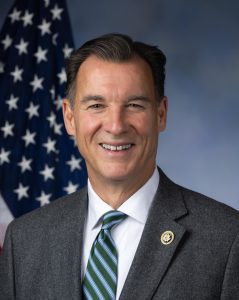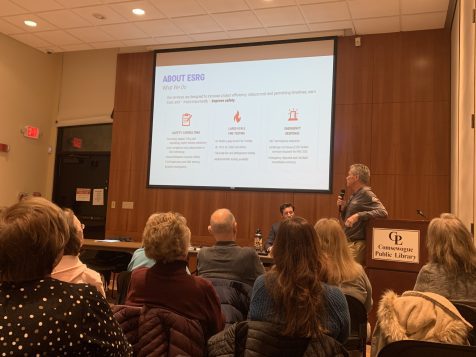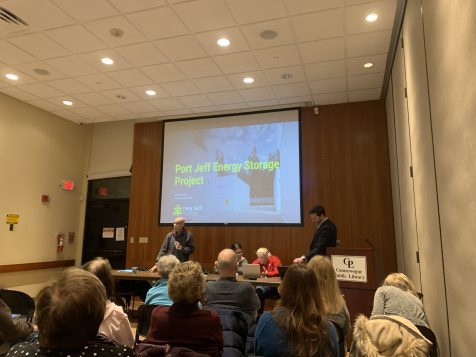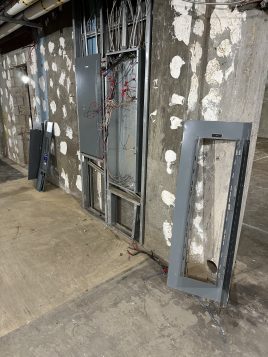By Sabrina Artusa
The Incorporated Village of Port Jefferson Board of Trustees and the Town of Brookhaven Council met for a joint public hearing for the prospective annexation of the Port Jefferson Station property on March 6.
James Tsunis, owner of the 5.6-acre parcel next to Baylis Avenue in Port Jefferson Station, initiated the historic hearing between the entities when he requested that five plots of land be annexed to Port Jefferson village. The last time the two entities met for a joint hearing was in 1978.

Tsunis and his company, Northwind Group, intend to develop the area into a 48-unit multifamily townhouse complex, which would be impossible under Brookhaven’s current industrial zoning. If the land is annexed, it will be in the purview of the Port Jefferson village planning board, and Tsunis would apply for a rezoning application with the village instead of the town. In this 3.5-hour meeting, Tsunis, as the petitioner, was to prove to both boards that there is a clear public benefit from annexation.
Previously, Brookhaven council members gave feedback indicating that if Tsunis were to submit a rezoning application, it would be rejected.
Tsunis, a 50-year Port Jefferson resident, said “None of the residents of the Village of Port Jefferson want industrial [development] on the property. So what do we do? We annex it into the village because that is who is affected by the use of this property.”
In conjunction with his Brook Meadows plan, Tsunis would contribute $500,000 to the village, assist in rebuilding the William Tooker House, the oldest structure in the village, build a community garden and build a sidewalk from the property to Sheep Pasture Road.
Baylis Avenue and Sheep Pasture Road
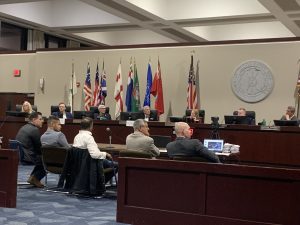
Tsunis’ attorney Michael Towey argued that the singular access road to the property from Sheep Pasture Road, which serves as the border between the town and the village, is problematic. “This section is completely geographically isolated from the town. It is only accessible through the village,” Towey said.
Since Sheep Pasture Road is the only entry point, Towey argued that the village residents will be affected by whatever is built on the parcel. “We believe the village and its residents [have] reason to be concerned not in the sense of any imminent threat, but in the sense that they presently lack control over how this territory or how these properties will be utilized in the future,” he said.
Supervisor Dan Panico (R) said that any property adjacent to an incorporated village would be implicated by that argument. Indeed, in order to reach Scenic View Court, a residential area neighboring Baylis Avenue, one must pass through the village from the east, though the road can be accessed without entering the village from the west. The Port Jefferson Marina, owned by the Town of Brookhaven, requires passing through the village.
Services
If the annexation is approved by both boards, the children who reside on the property would attend the Comsewogue School District, despite living in the village. The properties are currently serviced by the Terryville Fire District and will remain so even if the property is annexed. “An annexation of the property would place a division in unity of purpose of the public services providing emergency and educational services,” Town of Brookhaven Planning Director Don Hohn said.

Towey argued that the village already assumes responsibility for the road, and including the road in Brookhaven’s district was not efficient, although this could not be proven. Brookhaven paved the road in 2023.
Town of Brookhaven Superintendent of Highways Dan Losquadro (R) issued a letter of support of the annexation, writing “this will alleviate the duplication of services by more than one municipality on the same roadway.”
Some speakers reiterated the revitalization of Port Jefferson village as a benefit of the Brooks Meadows plan. Of the 24 speakers that addressed the board, 18 were in support of the development.
Jim Steiner hopes Brooks Meadows would breathe new life into the village: “[Revitalization] has been a slow process and to have a townhouse type place within walking distance will help lift up the neighborhood.”
Industrial vs. Multifamily
Hohn noted the increased traffic associated with multifamily zoning, stating that the daily trips would be lower if the area remains zoned industrial. “If the maximum building size allowed on a L1 industrial lot were to be developed, this would generate 214 total daily trips. The maximum building size on a multifamily lot, were it to be developed, would be 372 daily trips.” This assertion was corroborated by the Town of Brookhaven Highway Department, though the letter added that the traffic wouldn’t create “significant traffic impacts.” The maximum building height would be 50 feet in light industrial zoning and 35 feet in multifamily zoning in Brookhaven.
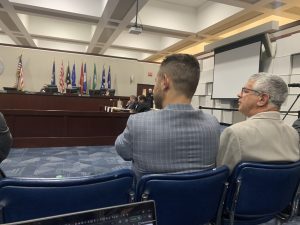
Many residents expressed displeasure over the aspect of letting the property remain industrial. Port Jefferson resident Gary Zamek said, “The Village of Port Jefferson does not need more industrial land on Sheep Pasture Road…I know Port Jefferson is trying to revitalize our uptown area. It just seems obvious to me that more residents as opposed to trucks would help create that.”
Businesses such as health clubs, offices, warehouses and veterinary hospitals would all be permitted in an area zoned industrial, as noted in Chapter 85 in Brookhaven’s town zone.
Further, some speakers supported the annexation as it would supply additional housing. Town of Brookhaven Councilman Jonathan Kornreich (D, Stony Brook) said, “On the application, it indicated there would be four affordable units…This will not be affordable housing by any means. Four of them will be.”
“As a trustee, I want to see owned real estate,” Port Jefferson village Trustee Xena Ugrinsky said.
The Brook Meadows site proposal was analyzed by the Suffolk County Department of Economic Planning and Development in 2023 before it was removed for consideration by Tsunis. The plan was analyzed and disapproved by the Suffolk County Department of Economic Planning and Development in 2023, citing incongruence with adjacent industrial zoning, additional traffic and that a change of zone is simply unnecessary and prohibitive to prospective light industrial zoning developments. The walkability score from the property was listed as 56 partly due to its distance to the Port Jefferson Train Station and downtown, an estimated 10-minute walk. Tsunis then withdrew his application.
“If it was to be developed industrially, it would likely, in my opinion, be developed into something more demure when it comes to light industrial like a self-storage, which is typically a generator of almost zero,” Panico said.
The prospect of a rail yard being built by the Metropolitan Transportation Authority at the Lawrence Aviation site is another consideration of the Brookhaven town council. Tsunis included a 100-foot buffer from the tracks in his plan, but Panico argued that this location would not be in the public’s best interest.
The town and the village have to vote on the annexation within 90 days of the hearing. If the town and village don’t vote in agreement, then one entity could appeal the other’s decision, according to Town of Brookhaven Attorney James Burke.
The public comment period closes on March 14 at midnight for online submissions and at 4:30 p.m. for physical submissions by mail.



